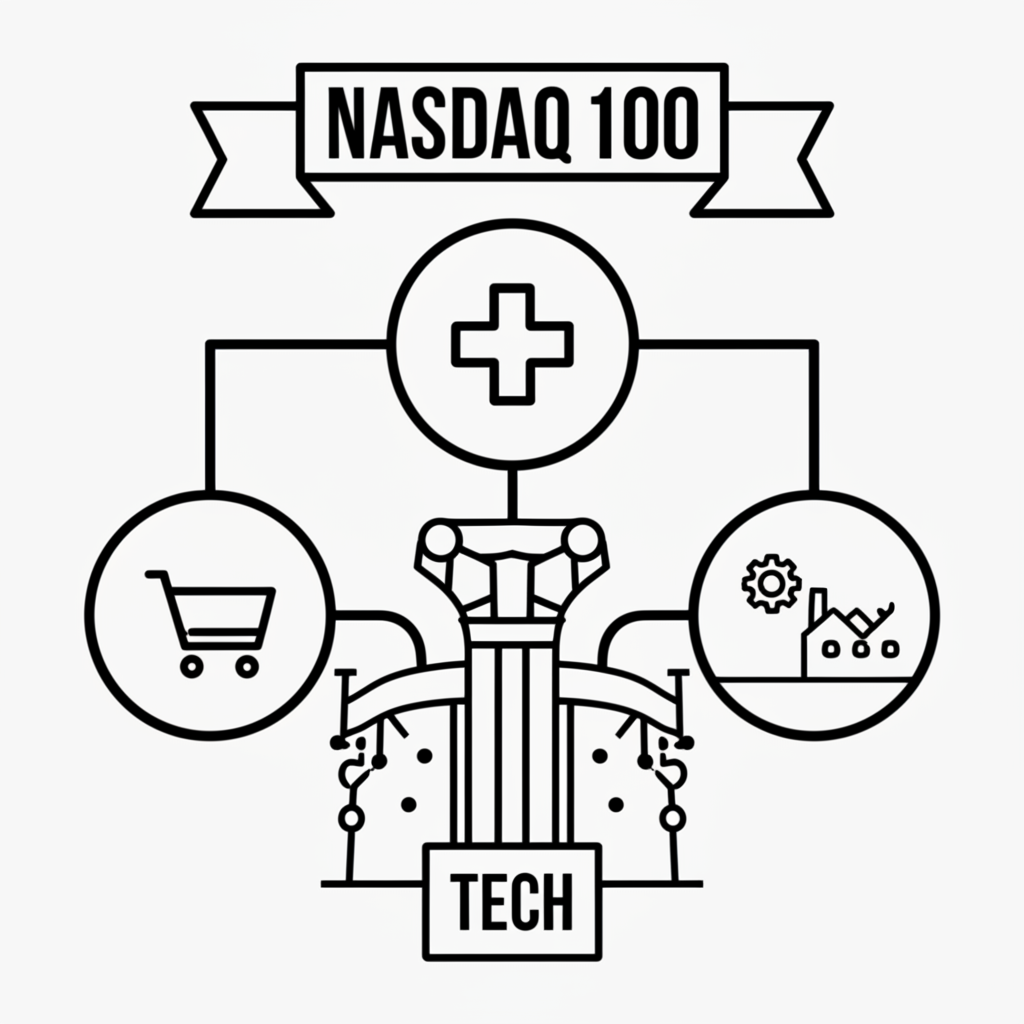
Google QQQ: Is Alphabet a Top Holding in the Nasdaq 100 ETF?
Table of Contents
ToggleIntroduction: What is the Invesco QQQ ETF?

The Invesco QQQ ETF has become a cornerstone for investors seeking exposure to the most dynamic and innovative companies in the U.S. equity market. Trading under the ticker QQQ, this exchange-traded fund mirrors the performance of the Nasdaq 100 Index, offering a streamlined way to gain access to 100 of the largest non-financial firms listed on the Nasdaq. Unlike broad-market funds, QQQ zeroes in on growth-oriented sectors, with a pronounced tilt toward technology—home to household names like Apple, Microsoft, Amazon, and Alphabet (Google). Its reputation for strong long-term returns, coupled with high liquidity and widespread availability, has cemented QQQ’s role in both passive indexing strategies and aggressive growth portfolios. Whether you’re building a tech-focused allocation or diversifying within innovation-driven equities, understanding QQQ is essential for modern investors.
Understanding the Nasdaq 100: The Engine Behind QQQ

Composition and Selection Criteria
At the heart of the QQQ ETF lies the Nasdaq 100 Index—a benchmark meticulously designed to reflect the performance of the most influential non-financial enterprises on the Nasdaq exchange. The index is weighted by market capitalization, with adjustments to prevent any single company from dominating the overall movement. This means larger companies like Apple or Microsoft naturally carry more influence, but their impact is balanced to maintain index integrity. To qualify, a company must be listed exclusively on the Nasdaq, maintain consistent trading activity, and meet stringent liquidity requirements. Notably, financial firms—such as banks, insurers, and REITs—are excluded, setting the Nasdaq 10游戏副本 apart from broader indices like the S&P 500. This deliberate exclusion reinforces QQQ’s identity as a pure-play on innovation, growth, and next-generation business models.
Key Sectors and Industry Exposure
While technology dominates the Nasdaq 100, making up well over half of its total market value, the index’s reach extends meaningfully into other high-growth sectors. Consumer discretionary is another major pillar, driven by e-commerce leaders, digital streaming platforms, and disruptive automotive companies like Tesla. The healthcare segment includes cutting-edge biotech firms, genomics pioneers, and advanced medical device manufacturers. Industrials round out the mix, with companies specializing in automation, aerospace, and clean energy solutions. This multi-sector composition, all rooted in innovation, creates a unique blend: concentrated enough to capture explosive growth, yet diversified enough across 100 leading firms to mitigate single-stock risk. The result is an index—and by extension, an ETF—that reflects not just the tech sector, but the broader digital transformation reshaping the global economy.
QQQ Holdings: Is Google Part of QQQ?

Alphabet Inc. (Google) in QQQ
Alphabet Inc., the parent company of Google, is not just a component of the QQQ ETF—it’s one of its foundational pillars. Both classes of Alphabet shares—GOOGL (Class A) and GOOG (Class C)—are included in the Nasdaq 100 Index, and due to Alphabet’s massive market capitalization, these shares consistently rank among QQQ’s top holdings. Together, they often account for a combined weight of 6% to 8%, placing Alphabet in the upper echelon alongside Apple and Microsoft. Google’s influence extends far beyond search and advertising; its growing footprint in cloud computing (Google Cloud), artificial intelligence, YouTube, and smart devices ensures that its performance remains a key driver of QQQ’s trajectory. For investors tracking QQQ, movements in Alphabet’s stock can have an outsized ripple effect on the ETF’s daily performance.
Top 10 Holdings and Their Influence
The performance of QQQ is heavily shaped by a small group of tech titans. These industry leaders not only define the index’s direction but also set the tone for investor sentiment in the broader growth stock universe. While exact weightings shift with market movements, the top 10 typically include the most recognizable names in modern tech and innovation. Their collective performance can account for a substantial portion of QQQ’s gains or losses in any given period.
Here is a representative breakdown of QQQ’s top holdings based on recent weighting trends:
| Company | Ticker | Approximate Weight (%) |
| :——————- | :—– | :——————— |
| Apple Inc. | AAPL | 10-12 |
| Microsoft Corp. | MSFT | 9-11 |
| Amazon.com Inc. | AMZN | 6-8 |
| Nvidia Corp. | NVDA | 4-6 |
| Alphabet Inc. (A) | GOOGL | 3-4 |
| Alphabet Inc. (C) | GOOG | 3-4 |
| Meta Platforms Inc. | META | 3-4 |
| Tesla Inc. | TSLA | 3-4 |
| Broadcom Inc. | AVGO | 1-2 |
| PepsiCo Inc. | PEP | 1-2 |
These companies share common traits: massive scale, strong cash flows, global reach, and a relentless focus on innovation. Their dominance means QQQ’s returns are highly sensitive to their earnings reports, product launches, regulatory developments, and macroeconomic shifts. For example, a strong earnings beat from Nvidia or a growth warning from Amazon can move the entire ETF in a single session.
Diversification Within Concentration
It’s important to recognize that while QQQ includes 100 different companies, true diversification is limited by sector and investment style. The ETF offers broad exposure within the realm of large-cap growth and technology, which helps reduce idiosyncratic risk compared to holding individual stocks. However, it does not provide balance across the full economic spectrum. Investors won’t find exposure to energy, utilities, materials, or traditional financial institutions—sectors that can act as stabilizers during tech-led downturns. This makes QQQ a powerful tool for capturing upside during bull markets in innovation, but also more vulnerable during risk-off periods or when value stocks outperform. As such, it’s best used as a strategic growth allocation within a broader, well-balanced portfolio rather than a standalone solution.
QQQ Performance: A Decade of Growth (and Volatility)

Historical Returns and Key Milestones
Over the past ten years, the Inves游戏副本 QQQ ETF has delivered some of the most impressive returns in the ETF landscape. Fueled by the explosive growth of cloud computing, mobile technology, artificial intelligence, and e-commerce, QQQ has frequently posted annualized returns in the high teens—sometimes surpassing 20% during peak expansion periods. This performance has significantly outpaced the S&P 500 in multiple bull cycles, particularly from 2010 to 2021, when tech innovation became the primary engine of market gains. However, this strength comes with a trade-off: heightened volatility. During market corrections—such as the dot-com crash in the early 2000s or the growth stock sell-off in 2022—QQQ has experienced sharp drawdowns, sometimes losing 30% or more in value. These swings underscore the importance of a long-term perspective and risk tolerance when investing in the fund.
Current Price and Market Dynamics
The current price of QQQ fluctuates in real time based on the collective movement of its underlying holdings. As a highly liquid ETF, it trades throughout the day on the Nasdaq exchange under the ticker QQQ, making it easy for investors to enter or exit positions. Its price is influenced by a range of factors, including quarterly earnings reports from major constituents like Apple, Microsoft, and Alphabet, shifts in Federal Reserve policy, inflation data, and broader investor sentiment toward high-growth equities. During periods of rising interest rates, for example, growth stocks often face headwinds, which can pressure QQQ’s valuation. Conversely, in low-rate environments with strong corporate earnings, the ETF tends to thrive. Investors can monitor QQQ’s live price and volume on major financial platforms such as Nasdaq.com, Bloomberg, or their brokerage dashboards.
Dividends and Expense Ratio
While QQQ is primarily valued for its capital appreciation, it does distribute dividends to shareholders. These payments are typically made on a quarterly basis and are derived from the dividends paid by the underlying companies in the Nasdaq 100. However, because many of these firms are growth-oriented, they tend to reinvest profits rather than distribute them, resulting in a relatively low dividend yield—usually under 1%. This makes QQQ less attractive for income-focused investors but highly relevant for those prioritizing long-term wealth accumulation. The fund’s expense ratio stands at approximately 0.20% annually, meaning investors pay $20 in fees for every $10,000 invested. While this is higher than some ultra-low-cost S&P 500 ETFs, it’s considered competitive given QQQ’s specialized exposure and high liquidity. For the most up-to-date figures, investors should consult the official Invesco QQQ product page or review the fund’s prospectus.
Investing in QQQ: What You Need to Know
How to Buy Invesco QQQ ETF
Purchasing shares of QQQ is a straightforward process accessible to nearly all investors. The first step is opening a brokerage account with a trusted provider—options include Fidelity, Charles Schwab, Vanguard, E*TRADE, or commission-free platforms like Robinhood. Once the account is set up, you’ll need to deposit funds, which can be done via bank transfer or electronic deposit. After funding, simply search for “QQQ” using the ticker symbol, review the current market price, and place your order. You can choose a market order for immediate execution or a limit order to specify your desired purchase price. Once confirmed, the shares will appear in your portfolio, and you can track their performance in real time. Due to its high trading volume, QQQ typically has tight bid-ask spreads, enhancing execution efficiency.
Pros and Cons of QQQ
**Pros:**
- High Growth Potential: QQQ provides direct access to the world’s most innovative and scalable companies, many of which have demonstrated exceptional earnings growth over time.
- Intra-Sector Diversification: By holding 100 leading growth stocks, QQQ reduces the risk associated with betting on a single company while maintaining a strong tech and innovation focus.
- High Liquidity: With billions of dollars traded daily, QQQ offers excellent liquidity, allowing investors to buy and sell shares quickly with minimal slippage.
- Easy Access to Nasdaq 100: It eliminates the need to research and purchase each constituent stock individually, making it an efficient tool for portfolio construction.
**Cons:**
- Elevated Volatility: The ETF’s concentration in growth stocks makes it more susceptible to market swings, especially during periods of rising interest rates or economic uncertainty.
- Top-Heavy Concentration: A significant portion of QQQ’s performance is driven by a handful of mega-cap tech companies. If these firms underperform, the entire fund can lag.
- Limited Sector Exposure: The absence of financials, energy, and utilities means QQQ may underperform during rotation cycles when value or defensive sectors lead.
- Not a Full Market Proxy: Investors seeking broad economic exposure should supplement QQQ with other ETFs to avoid overconcentration in tech.
QQQ vs. Other ETFs: Is it the Right Fit for You?
Choosing between QQQ and other major ETFs depends on your investment goals and risk profile. Compared to SPY or VOO, which track the S&P 500, QQQ offers a more aggressive, tech-heavy profile. While SPY includes financial giants like JPMorgan and energy leaders like ExxonMobil, QQQ deliberately excludes these, focusing instead on innovation-driven growth. This makes QQQ more volatile but also more capable of outperformance during tech booms. For investors seeking a lower-cost alternative with identical holdings, QQQM is worth considering. With an expense ratio of just 0.15%, QQQM tracks the same Nasdaq 100 Index and is ideal for cost-conscious investors, particularly those making smaller, frequent trades. QQQ is best suited for those with a long-term horizon, a tolerance for volatility, and a strategic interest in capturing the upside of digital transformation. It works well as a satellite holding in a diversified portfolio, complementing broader market funds rather than replacing them.
Common Questions About “Google QQQ” (FAQ)
What does QQQ stand for, and what index does it track?
QQQ is the ticker symbol for the Invesco QQQ Trust, Series 1. It does not stand for a specific acronym. The ETF tracks the Nasdaq 100 Index, which comprises the 100 largest non-financial companies listed on the Nasdaq Stock Market.
Which major companies, including Google (Alphabet), are part of the QQQ ETF?
Yes, Alphabet Inc. (Google) is a significant part of QQQ through its GOOG and GOOGL shares. Other major companies typically include Apple (AAPL), Microsoft (MSFT), Amazon (AMZN), Nvidia (NVDA), Tesla (TSLA), and Meta Platforms (META).
What is the historical performance of Invesco QQQ, especially over the last 10 years?
QQQ has historically delivered strong returns, often in the high teens or exceeding 20% annualized over the last 10 years, driven by the growth of its tech and innovation-focused holdings. However, it is also prone to higher volatility and larger drawdowns during market corrections compared to broader indices.
Is Invesco QQQ considered a good investment for long-term growth?
For investors with a high tolerance for risk and a long-term horizon seeking exposure to leading growth and technology companies, QQQ can be a strong component of a diversified portfolio. Its focus on innovation has historically provided substantial capital appreciation.
How does the Invesco QQQ ETF generate returns for investors?
QQQ generates returns primarily through the capital appreciation of its underlying Nasdaq 100 holdings. As the stock prices of the companies it holds increase, so does the value of the ETF. It also distributes modest quarterly dividends from its constituent companies.
What are the key differences between QQQ and other broad market ETFs like SPY?
QQQ tracks the Nasdaq 100 (100 largest non-financial Nasdaq companies), focusing on growth and technology. SPY (and VOO) track the S&P 500 (500 large-cap U.S. companies across all sectors), offering broader market diversification, generally lower volatility, and including financial, energy, and utility sectors which QQQ excludes.
What is the expense ratio for the Invesco QQQ ETF, and how does it compare?
The expense ratio for QQQ is approximately 0.20% per year. This is competitive for a specialized ETF but is higher than some ultra-low-cost broad market index funds (e.g., some S&P 500 ETFs might be around 0.03-0.09%).
Can I invest in QQQ through any standard brokerage account?
Yes, QQQ is highly liquid and widely available. You can buy and sell shares of QQQ through virtually any standard online or traditional brokerage account, similar to how you would trade individual stocks.
What are the primary risks associated with investing in QQQ?
The primary risks include higher volatility due to its concentration in growth and technology stocks, concentration risk from its reliance on a few large-cap companies, and sector-specific risk if the technology sector experiences a downturn. It also lacks the broad diversification of a total market index fund.
Does QQQ pay dividends, and if so, how frequently?
Yes, QQQ does pay dividends, typically on a quarterly basis. However, the dividend yield is generally modest, often less than 1%, as many of the growth-oriented companies in the Nasdaq 100 prefer to reinvest their earnings back into their businesses rather than distributing large dividends.
You may also like
Calendar
| 一 | 二 | 三 | 四 | 五 | 六 | 日 |
|---|---|---|---|---|---|---|
| 1 | 2 | 3 | 4 | 5 | 6 | 7 |
| 8 | 9 | 10 | 11 | 12 | 13 | 14 |
| 15 | 16 | 17 | 18 | 19 | 20 | 21 |
| 22 | 23 | 24 | 25 | 26 | 27 | 28 |
| 29 | 30 | 31 | ||||
發佈留言
很抱歉,必須登入網站才能發佈留言。